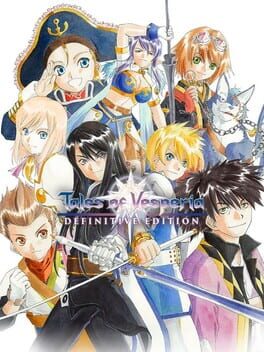From the first line of the first verse of Vesperia's incredibly cheesy english-dubbed opening, I felt like I was revisiting a game from my childhood despite knowing for a fact that I wasn't. I think most Tales Of entries of its era share this anemoiac quality to some extent, but Vesperia hits different thanks to its sheer honesty and relative lack of ambition. Above all else, It's a character-driven game. Of course, there's a global conflict in there and a bizarrely sharp (or at least surprisingly so for the genre) bit of commentary including a cop's slow realization that they may, in fact, all be bastards, but playing the game for anything other than the cast is bound to get old fast.
To focus on them, Vesperia resorts to familiarity. Put simply, it's Final Fantasy IX, from its introduction to its structure and the inner workings of its equipment and skills. Squaresoft's is a far more ambitious game, constantly moving between setpieces and elegantly shuffling the party to maintain the tight pacing of a blockbuster, which can make its lower-budget sibling feel awkward in the way it incorporates truncated versions of its core elements, but the tradeoff is usually worth it. Vesperia doesn't need to explain anything to you, so it can focus on what it's good at.
While not pre-rendered, the game relies on fixed camera angles and paths to make the best of each tiny locale. A walk through a town is a nicely designed oner that suggests not just the space but its atmosphere and the characters' place within it. Behind the models, multiplanar matte paintings make for spectacular vistas and small navigational disappointments that are definitely better for the mood than later entries' obviously artificial open spaces. In an exercise in focus and restraint, every slice of Vesperia's world is a memorable little set for the party to exist in.
Also in line with the "less is more" approach, the characters' personalities can be summed up in a sentence each, which is bad news for people who make a hobby of equating "familiar" with "generic", but has the benefit of making them immediately iconic while leaving a lot of space for nuance. They join the party naturally and take little time to fit in. The skits (opt-in sequences that build up character dynamics and are just great fun overall) work their magic in the background and by the time everyone is officially together, you've seen them in enough situations to span a 48-episode SoL anime. It may not make for an instant epic--in fact, the story itself isn't all that important--but it can turn any minor situation involving them into effective drama. I just love the party, really. Watching them grow closer and find excuses to stay together even when they've achieved their individual goals and could legitimately just leave gives me so much joy.
The game's only real problems come from the times its design and structure betray the character focus. There's a lot of side content peppered throughout the world, but most of it is only accessible during the final act, when urgency is at its highest and you're used to not backtracking to find hilarious new dialogue in towns you've already seen. My advice is to periodically check them out if you want that extra bit of texture and character. For the ending, though, I don't have any advice. Once the final battle's over, the game is just kind of done. Most character arcs have gotten some closure by that point, but a lengthy epilogue was so obviously the right choice that I was baffled when the credits just started rolling.
"I enjoyed the characters so much that I wouldn't have minded another 20 hours of skits" is about the most positive complaint I could have, though, and the journey was lovely. Looking back at the game feels like remembering an old trip with friends, and that sort of nostalgic feeling is a reprise of the reason I picked it up in the first place.
